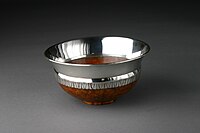
Furniture refers to objects intended to support various human activities such as seating, eating (tables), storing items, working, and sleeping. Furniture is also used to hold objects at a convenient height for work, or to store things. Furniture can be a product of design and can be considered a form of decorative art. In addition to furniture's functional role, it can serve a symbolic or religious purpose. It can be made from a vast multitude of materials, including metal, plastic, and wood. Furniture can be made using a variety of woodworking joints which often reflects the local culture.

A thimble is a small pitted cup worn on the finger that protects it from being pricked or poked by a needle while sewing. The Old English word þȳmel, the ancestor of thimble, is derived from Old English þūma, the ancestor of the English word thumb.

The tradition of wassailing falls into two distinct categories: the house-visiting wassail and the orchard-visiting wassail. The house-visiting wassail is the practice of people going door-to-door, singing and offering a drink from the wassail bowl in exchange for gifts; this practice still exists, but has largely been displaced by carol singing. The orchard-visiting wassail refers to the ancient custom of visiting orchards in cider-producing regions of England, reciting incantations and singing to the trees to promote a good harvest for the coming year. Notable traditional wassailing songs include "Here We Come a-Wassailing", "Gloucestershire Wassail", and "Gower Wassail".

Tableware items are the dishware and utensils used for setting a table, serving food, and dining. The term includes cutlery, glassware, serving dishes, serving utensils, and other items used for practical as well as decorative purposes. The quality, nature, variety and number of objects varies according to culture, religion, number of diners, cuisine and occasion. For example, Middle Eastern, Indian or Polynesian food culture and cuisine sometimes limits tableware to serving dishes, using bread or leaves as individual plates, and not infrequently without use of cutlery. Special occasions are usually reflected in higher quality tableware.

A bowl is a typically round dish or container generally used for preparing, serving, storing, or consuming food. The interior of a bowl is characteristically shaped like a spherical cap, with the edges and the bottom forming a seamless curve. This makes bowls especially suited for holding liquids and loose food, as the contents of the bowl are naturally concentrated in its center by the force of gravity. The exterior of a bowl is most often round, but can be of any shape, including rectangular.

The Holy Chalice, also known as the Holy Grail, is in Christian tradition the vessel that Jesus used at the Last Supper to share wine. The Synoptic Gospels refer to Jesus sharing a cup of wine with the Apostles, saying it was the covenant in his blood. The use of wine and chalice in the Eucharist in Christian churches is based on the Last Supper story. In the late 12th century, the author Robert de Boron associated the pre-existing story of the Holy Grail, a magical item from Arthurian literature, with the Holy Chalice. This association was continued in many subsequent Arthurian works, including the Lancelot-Grail (Vulgate) cycle, the Post-Vulgate Cycle, and Sir Thomas Malory's Le Morte d'Arthur. A cup kept in the Spanish Cathedral of Valencia has been identified since medieval times as the purported Holy Chalice used at the Last Supper.

A pyx or pix is a small round container used in the Catholic, Old Catholic, Lutheran and Anglican Churches to carry the Eucharist, to the sick or those who are otherwise unable to come to a church in order to receive Holy Communion. The term can also be used in archaeology and art history to describe small, round lidded boxes designed for any purpose from antiquity or the Middle Ages, such as those used to hold coins for the Trial of the Pyx in England.

A ciborium is a vessel, normally in metal. It was originally a particular shape of drinking cup in Ancient Greece and Rome, but the word later came to refer to a large covered cup designed to hold hosts for, and after, the Eucharist, thus the counterpart of the chalice.
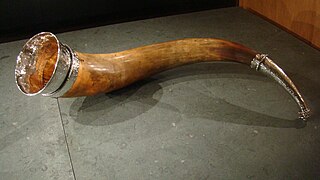
A drinking horn is the horn of a bovid used as a drinking vessel. Drinking horns are known from Classical Antiquity, especially the Balkans, and remained in use for ceremonial purposes throughout the Middle Ages and the Early Modern period in some parts of Europe, notably in Germanic Europe, and in the Caucasus. Drinking horns remain an important accessory in the culture of ritual toasting in Georgia in particular, where they are known by the local name of kantsi.

Opus Anglicanum or English work is fine needlework of Medieval England done for ecclesiastical or secular use on clothing, hangings or other textiles, often using gold and silver threads on rich velvet or linen grounds. Such English embroidery was in great demand across Europe, particularly from the late 12th to mid-14th centuries and was a luxury product often used for diplomatic gifts.
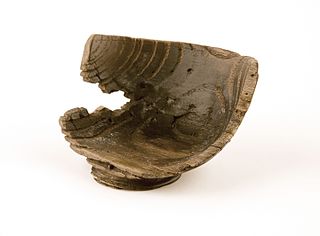
The Nanteos Cup is a medieval wood mazer bowl, held for many years at Nanteos Mansion, near Aberystwyth in Wales.

A nef is an extravagant table ornament and container used in the Middle Ages and Renaissance, made of precious metals in the shape of a ship – nef was another word for a carrack in French. If not just used for decoration, it could hold salt or spices, or cutlery, or even napkins. The large nef depicted in the well-known calendar miniature for January from the Très Riches Heures du Duc de Berry is being used to hold, and perhaps wash, gilt dishes from the table service.

A cage cup, also vas diatretum, plural diatreta, or "reticulated cup" is a type of luxury late Roman glass vessel, found from roughly the 4th century, and "the pinnacle of Roman achievements in glass-making". Diatreta consist of an inner beaker and an outer cage or shell of decoration that stands out from the body of the cup, to which it is attached by short stems or shanks. About fifty cups or, more often, fragments have survived, and there are only a few in near-complete condition. Most have a cage with circular geometrical patterns, often with an "inscription", or phrase in letters above the reticulated area as well. Some have a flange, or zone of projecting open-cut moulding, above the lower patterns and below the lettering.

Silver-gilt or gilded/gilt silver, sometimes known in American English by the French term vermeil, is silver which has been gilded with gold. Most large objects made in goldsmithing that appear to be gold are actually silver-gilt; for example most sporting trophies and many crown jewels are silver-gilt objects.
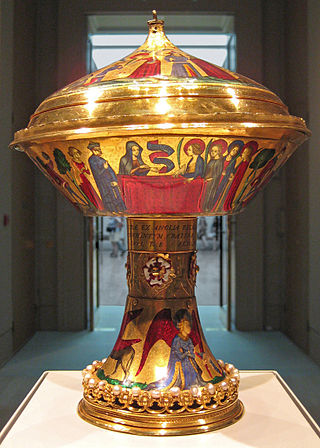
The Royal Gold Cup or Saint Agnes Cup is a solid gold covered cup lavishly decorated with enamel and pearls. It was made for the French royal family at the end of the 14th century, and later belonged to several English monarchs before spending nearly 300 years in Spain. It has been in the British Museum since 1892, where it is normally on display in Room 40, and is generally agreed to be the outstanding surviving example of late medieval French plate. It has been described as "the one surviving royal magnificence of the International Gothic age". According to Thomas Hoving, former director of the Metropolitan Museum of Art in New York, "of all the princely jewels and gold that have come down to us, this is the most spectacular—and that includes the great royal treasures."

The Ormside Bowl is an Anglo-Saxon double-bowl in gilded silver and bronze, with glass, perhaps Northumbrian, dating from the mid-8th century which was found in 1823, possibly buried next to a Viking warrior in Great Ormside, Cumbria, though the circumstances of the find were not well recorded. If so, the bowl was probably looted from York by the warrior before being buried with him on his death. The bowl is one of the finest pieces of Anglo-Saxon silverwork found in England.
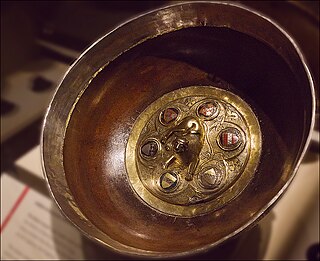
The Bute Mazer, also known as the Bannatyne Mazer is a medieval communal feasting cup of a type known as a mazer. The wood bowl and the elaborate silver-gilt "boss" in the centre are dated "fairly firmly" to between 1314 and 1327 from the heraldry, with the rim and cover about 1500. It is the oldest Scottish mazer still surviving, and one of the oldest and most elaborate British ones. The cup has long been associated with the Isle of Bute, on the west coast of Scotland. Its alternative name derives from Ninian Bannatyne, Laird of Kames, who owned the cup in the 16th century and had his name engraved on the rim. The mazer is now on loan from the Bannatyne family to the National Museum of Scotland in Edinburgh.

In the early Middle Ages, there were distinct material cultures evident in the different federations and kingdoms within what is now Scotland. Pictish art was the only uniquely Scottish medieval style; it can be seen in the extensive survival of carved stones, particularly in the north and east of the country, which hold a variety of recurring images and patterns. It can also be seen in elaborate metal work that largely survives in buried hoards. Irish-Scots art from the kingdom of Dál Riata suggests that it was one of the places, as a crossroads between cultures, where the Insular style developed.
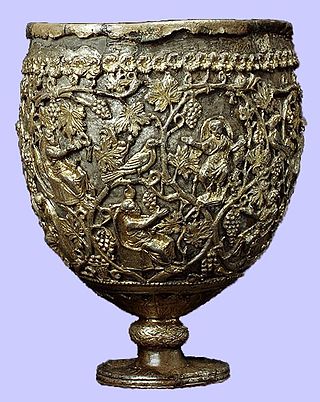
Silver was important in Byzantine art and society more broadly as it was the most precious metal right after gold. Byzantine silver was prized in official, religious, and domestic realms. Aristocratic homes had silver dining ware, and in churches silver was used for crosses, liturgical vessels such as the patens and chalices required for every Eucharist. The imperial offices periodically issued silver coinage and regulated the use of silver through control stamps. About 1,500 silver plates and crosses survive from the Byzantine era.
James Gray was a Scottish goldsmith working in Edinburgh during the reigns of Mary, Queen of Scots and James VI of Scotland. Gray is known for the "Galloway mazer", a gilt cup now held by the National Museums of Scotland. He also engraved the brass plate for the tomb of Regent Moray in St Giles, Edinburgh.


![Mazer, maplewood with silver-gilt mounts, made around 1380. The boss is engraved with the sacred monogram "IHC" [Jesus]. The mounts are engraved, 'Hold yowre tunge and say ye best and let yowre neyzbore sitte in rest hoe so lustyye God to plese let hys neyzbore lyve in ese' (Hold your tongue and say the best / And let your neighbour sit in rest / He is so eager to please God / He lets his neighbour live in ease). Victoria and Albert Museum, London Mazervanda.jpg](http://upload.wikimedia.org/wikipedia/commons/thumb/9/94/Mazervanda.jpg/220px-Mazervanda.jpg)




